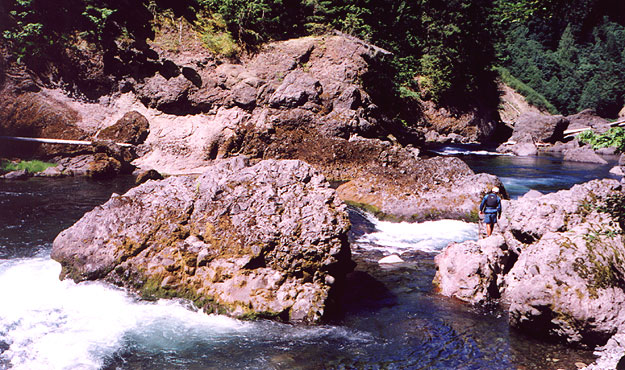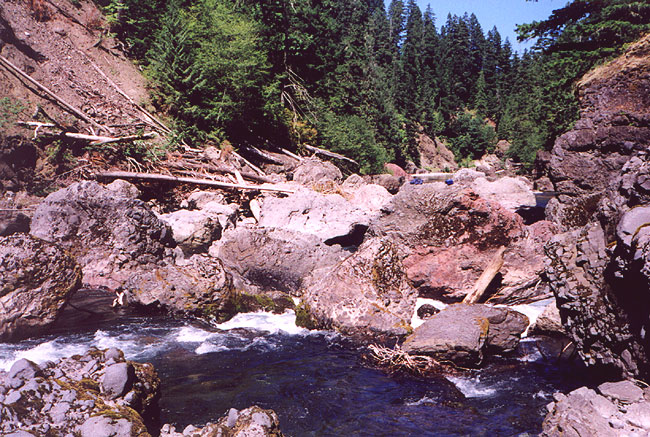
The Killer Fang section of the Clackamas is a very scenic and enjoyable class IV trip through a semi-remote forested canyon east of Portland. At the put in boaters have time to examine the huge sign put up by local authorities that assures them that the sky is going to fall, pigs are going to fly, and yes, Killer Fang is going too get you too!!
Of course, I don't mean to downplay the hazard posed by the class six Killer Fang (it has drowned a few people...) I'm just amused by the sign, which comes very close to saying that NO ONE should paddle this stretch. Maybe because of this you don't see that many boaters on this section. The trip starts out mellow and kind of stays that way, with a bit of flat water at the beginning. The rapids gradually increase in power as you approach the Killer Fang but none require a great deal of attention until you get to Drop Stopper, a class IV rapid just below a campground about halfway down. Drop Stopper starts where the river bends to the left after a pool and should be scouted as there is a log extending from the left bank at the bottom of the rapid.
The next major drop is Prelude. This drop starts with fast water and ends with a line of boulders. It pays to stay alert here because Killer Fang is a couple of hundred feet downstream. Catch the eddy on the left and examine the slots. We usually run the leftmost slot into the pool above Killer Fang. Note that these photos were taken at about 1000 cfs. At flows over 2000 cfs, the first part of this drop gets pushier and tends to pile into a large boulder on the right (pictured below). The eddy on the left is still there, but it gets a little smaller at that flow.
Pete scouts the slots at Prelude. The lead in to Killer Fang is just visible downriver.

Immediately after Prelude get out on the right and hike over the large jumble of boulders and gawk at the Killer Fang. Here the river tumbles over the coolest looking (and most unfortunately located) drop on the run and then slams into and disappears under a house sized boulder. At flows over 2000 cfs, this drop fills in a little and becomes semi-runnable, but I have never seen anyone do it.
A few years back a landslide came in just downstream from the fang, damming up the river and covering up the deadly undercut boulder that the river usually dives under. This made the drop runnable, but that is no longer the case. The old fang is back, so boaters beware!
Pete, dwarfed by the Killer Fang.

Portage on the right and put in behind the boulder and check out the funky hydraulics rising up from deep beneath the killer fang boulder. It's pretty interesting; heck, I think you should do this run just to see this drop!
Pete in the pool behind the Killer Fang boulder... This is the 'outlet' or the downstream side of the killer fang boulder.

Be careful below Killer Fang because just downstream is The Sieve, a bouldery jumble formed by an active landslide. At low flows boaters portage a log in the entrance slot on the far left after doing some tricky eddy hopping. At higher flows (2000+ cfs) boaters can run the far left side of the sieve, without portaging, but exercise caution because a wood-filled undercut waits below the entrance slot. (Flipping here means a paddler would be swept into the undercut, so scout carefully. It is not difficult to portage on the left.)
A final note of caution:
Paddlers need to be careful as they approach the sieve, especially at higher flows. There is a fast class III rapid that leads directly into The Sieve, with small eddies on the left that cannot be missed under any circumstances.
The Sieve as viewed from upstream. There is a class III rapid that leads
directly into this drop, with a mandatory right to left move. A swim or
roll
the lead-in drop would cause a paddler to be swept into the right side of
the sieve, which would likely prove fatal. At flows over 2000 cfs on
the Three Lynx gauge the lead-in rapid gets pushy, so come
prepared. This
photo was taken at 1000 cfs on the Three Lynx gauge.

Below The Sieve the river stays interesting all the way to the take out, with small but fun rapids and many more big, funky conglomerate boulders in the river channel. For an easier but no less interesting run, paddle the Three Lynx section below the take out and surf the infamous Bob's Hole, which is the site of an annual national rodeo.